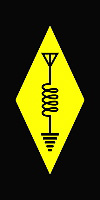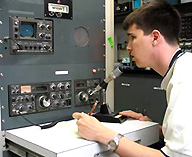CATALYTIC REACTIONS?
If you have a photo or other
graphic that reflects an aspect of life
(including laboratory life) or a
quotation that scientists might
appreciate that would be fit to print
in the space to the right, why not
send it to us via e-mail:
<catalyst@nih.gov>; fax: 402-4303; or mail: Building 2, Room 2E26.
Also,
we welcome "letters to the editor" for publication and your
reactions to anything on the Catalyst pages.
In Future Issues...
Inside the Doors of Building 33
Dual-Use Technology
Research Roundup
International radio symbol Kids' Catalyst
—The Joys of Amateur Radio
Driver’s license . . . ah, freedom! But you have to wait until you’re old enough,
and then you are still limited in where you can go and how fast you can get there, and you have responsibility for tires, gas, insurance, etc. It’s not all fun.But there’s another kind of license. . . one that will allow you to go to the other side of the country or overseas. Or to the moon or a space station–and you’ll be going at the speed of light!
What’s more, even if the power goes out—and you have no computer, no video games, no TV, no phone service—you could still be talking to people all over the world and you could also be helping with emergency assistance during something like a power outage.
Welcome to the world of amateur radio. There are people at their own radio stations all over the world, with radios, big and small, who aren’t limited to listening to that little section on the FM dial. With their receiver and transmitter (and license), they can listen and talk to people as far away as the space station—and beyond, once there are people beyond the space station. And you can, too.
The catch? Just as with a driver’s license, you have to take a test to get your amateur radio license, but it’s a test on information you’ll be excited to learn because it will allow you to operate a radio and to know what you’re doing.
There are lots of people who can help you get started, such as NIMH’s Andy Mitz (call sign WA3LTJ) of W3NIH, our very own radio club—the NIH Radio Amateur Club.
The radio club operates the Emergency Communications Center at NIH; it’s housed on the third floor of Building 11, the power plant. And that’s where the group meets the first Saturday of each month.
Andy can be reached by phone at 301-402-5573 or e-mail.
Information on how to apply for and get an amateur radio license can be found at the Federal Communications Commission website.
And the best site for information, according to Andy, is the American Radio Relay League.
—Jennifer White
call sign KB3QFD
|
PUBLISHER EDITORS Henry
Metzger
|
MANAGING
EDITOR Writer-Editor COPY
EDITOR CONTRIBUTING
WRITER |
EDITORIAL
ADVISORY BOARD
|

